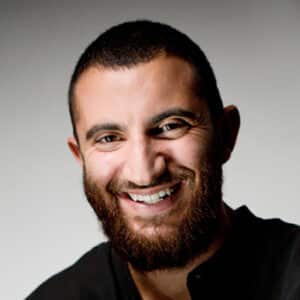
His biographer Thomas Veski has aptly called him a “chronicler of our time”: Martin Parr had always known he wanted to be a photographer. His father, George Parr, a photography enthusiast, encouraged him to take his first images, a photographic series of a popular fish-and-chips store in Yorkshire.
The photographer’s first retrospective in Belgium covers the three floors of the Brussels photography center, Le Hangar. It focuses on fifteen emblematic series by one of the most recognizable representatives of contemporary documentary photography. A modern-day satirist, Parr has always looked at the world around him, and the West in particular, with an offbeat, ironic gaze.

© Martin Parr/Magnum Photos
Parr was twenty-three when he and his partner Susie Mitchell moved to the small Yorkshire town of Hebden Bridge in 1975. Life was cheap, unpretentious, authentic, and dignified, and Parr spent five years photographing nature as well as the lives of workers, miners, farmers, believers, gamekeepers, and pigeon fanciers. The photographer thought of his work “as a celebration.” The images of that era make up his first major body of work, “The Non-Conformists”, named after the ubiquitous Methodist and Baptist chapels. They were shot in black and white, as were those in his next project, “The Bad Weather”, which, building on an obsession with the English climate, worked against the grain of the genre: “You are usually told to photograph only when the light is good and the sun is out, but I liked the idea of photographing only in bad weather, as a way of subverting the conventions.”
1982 marked a radical shift in Parr’s work: he abandoned black and white film and switched to color. Celebration of the world around him was transformed into a critique. Parr now sought to infuse his images with ambiguity and irony. He deployed his deadpan English humor: “We have an incredible sense of humor and irony. It is essential in my work… a fundamental component of British photography. It is our way of being and defining ourselves.” In “The Last Resort” Martin Parr denounces the end of a world (the working-class world) and its values, and the advent of a new conception of life. In an interview at the Parisian museum Jeu de Paume, on the occasion of the exhibition “Planet Parr” in 2009, Parr said, “I am very middle class myself, and I certainly bring my middle-class sensibility to my work as a photographer.”


England would always be Martin Parr’s favorite subject. He photographed the peripheries as well as the British establishment and the elites running the country. “Traditional photography takes poverty as a theme to illustrate concern for the other; I photograph wealth as a topic of human concern.” His exploration of wealth took him to Dubai, Durban, Miami, and Moscow; to fashion shows, art fairs, luxury goods markets, and even horse races. Pursuing his interest in the middle and working classes, Parr’s series “Luxury” is an uncompromising look at the behavior of an international class whose social codes are based on ostentatious spending.
Mass tourism – most famously featured in his photos of seaside resorts – became one of Parr’s favorite subjects, giving rise to several series taken in the four corners of the world: “The Last Resort”, “Small World”, and “Knokke-Le-Zoute”. “You can learn a lot about a country by looking at its beaches: from one culture to the next, it is one of the few public spaces where you come across the quirks and eccentricities that characterize a nation.” From his many travels, Parr would bring back every time one very special souvenir: a self-portrait. The resulting gallery of “Self-Portraits”, composed of images made by professional photographers, local amateurs, or produced in photo booths, poke fun at popular vacation snapshots. From overly manipulated digital photographs to studio shots with exotic backgrounds and colorized portraits — as a cosmonaut, or a judoka rubbing elbows with Vladimir Putin — we can trace the evolution of the artist’s caustic humor. Parr has continued to pursue his study of tourism, as well as devoted a new series to the self-portrait in “Death by Selfie”, focusing on a practice that has radically altered the ritual of tourism.

An enthusiast of images, Parr collects all sorts of objects, postcards, and fine art books. He is also a publisher. A member of Magnum since 1994, he has encouraged the agency’s photographers to expand their conception of social documentary photography, revolutionizing the milieu. He has never stopped questioning the world around him through his representations. In the preface to the monograph Luxe, fashion designer Paul Smith said of the photographer, “With Martin, it’s about revealing things, about showing what we are and how we live, portraying human life as it is not the way we would like it to be.” Martin Parr’s human life? A life full of humor, exuberance, wonder, and always a touch of wistfulness.
“Parrathon”, September 17 to December 18, 2021. Le Hangar, Place du Châtelain 18, 1050 Brussels, Belgium


